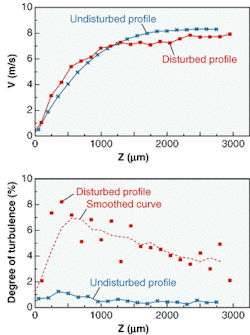Laser Doppler anemometry (LDA) is often used for spatially resolved velocity analysis of gas and liquid flow. In the technique, a fringe pattern is induced by crossing two coherent beams, the intersection of which defines a measurement spot within the flow. Tracer particles are added to the flow and scattered light is monitored. The frequency of the periodic signal is determined by the time required for the passage between neighboring fringes.
To obtain high local resolution—needed for tracing flows passing objects or for the study of turbulence—the observation volume must be kept as small as possible. In ordinary LDA, this is accomplished either by reducing the acceptance field of the detector optics or by focusing the beams more tightly, reducing the length of the fringe pattern. The first method suffers from reduced signal-to-noise ratio, while the second leads to curved fringes and a broadening of the Doppler signal.
Researchers at Laser Zentrum Hannover (Hannover, Germany) have found an elegant way around these drawbacks. In their technique, beams of lower spatial coherence are used for fringe-pattern generation.
The output of an optical fiber carrying light from a laser diode is split by a diffraction grating into plus and minus first-order beams, which are made to overlap in an approximately ellipsoidal volume. A standing-wave interference pattern is generated which, in ordinary Doppler anemometry, would extend over the whole ellipsoid. Ordinarily, the resolution of a velocity measurement would be equal to the length and width of the ellipsoid. By reducing the coherence, the researchers make the lateral extent of the fringe pattern much less than the length of the ellipsoid (in the longitudinal direction of the fringe pattern, a certain number of fringes must be maintained to obtain a sufficiently narrow Doppler signal).
Fiber reduces coherence
The key to achieving this reduction in coherence is to compose the interfering beams from light guided by a multimode optical fiber so that the emitted light no longer shows complete spatial coherence across the exit surface of the fiber. Instead, a fringe pattern forms only in the central part of the ellipsoid, where only rays emitted from the same local area on the fiber face interfere. In the polar regions of the ellipsoid, superposition arises from rays belonging to different, mutually uncorrelated fiber modes so that interference patterns are washed out. The higher the number of guided modes without correlation, the smaller becomes the fringe-pattern length.
Multimode emission can give rise, however, to speckle formation that would transform into intensity fluctuations in the fringe pattern, increasing noise in the Doppler signal. Speckle formation can be reduced by increasing the laser line width, thus decreasing the longitudinal coherence length, and by choosing long fibers so that the optical paths of higher modes differ by amounts higher than the coherence length.
The authors investigated the influence of the number of guided modes on the fringe-length reduction factor and applied the device to measure nonturbulent and turbulent flows.1, 2 For the latter, the diode laser emitted 700 mW of output power at an 810-nm wavelength with a linewidth of less than 4 nm. The step-index fiber had a 100-µm core diameter and a length of 5-m. The measurement volume was generated at a 50-mm working distance and showed about 100 interference fringes 300 µm down the flow; using 1/e2 intensity decay as the measure, the lateral length was about 80 µm. In this way, the fringe length was reduced to 3.5% of the beam superposition ellipsoid length.
Laminar and turbulent flows in boundary layers of a glass slab in a wind tunnel were investigated (see figure). The flow in the boundary layer was made turbulent by fixing a 1-mm-diameter wire to the surface of the slab upstream and transverse to the flow direction. Velocity measurement results were obtained by stepwise positioning of the measurement spot across the boundary region. To determine the precision of the system, the researchers made a separate measurement of the so-called virtual turbulence resulting from broadening of the Doppler signal, finding it to be only 5 × 10-4.
REFERENCES
- L. Büttner and J. Czarske, Meas. Sci. and Tech. 12, 1891 (2001).
- L. Büttner and J. Czarske, 11th Intl. Symp. App. of Laser Techniques to Fluid Mech., paper 21.3, 8 (July 2002, Lissabon/Portugal).
About the Author
Uwe Brinkmann
Contributing Editor, Germany
Uwe Brinkmann was Contributing Editor, Germany, for Laser Focus World.
